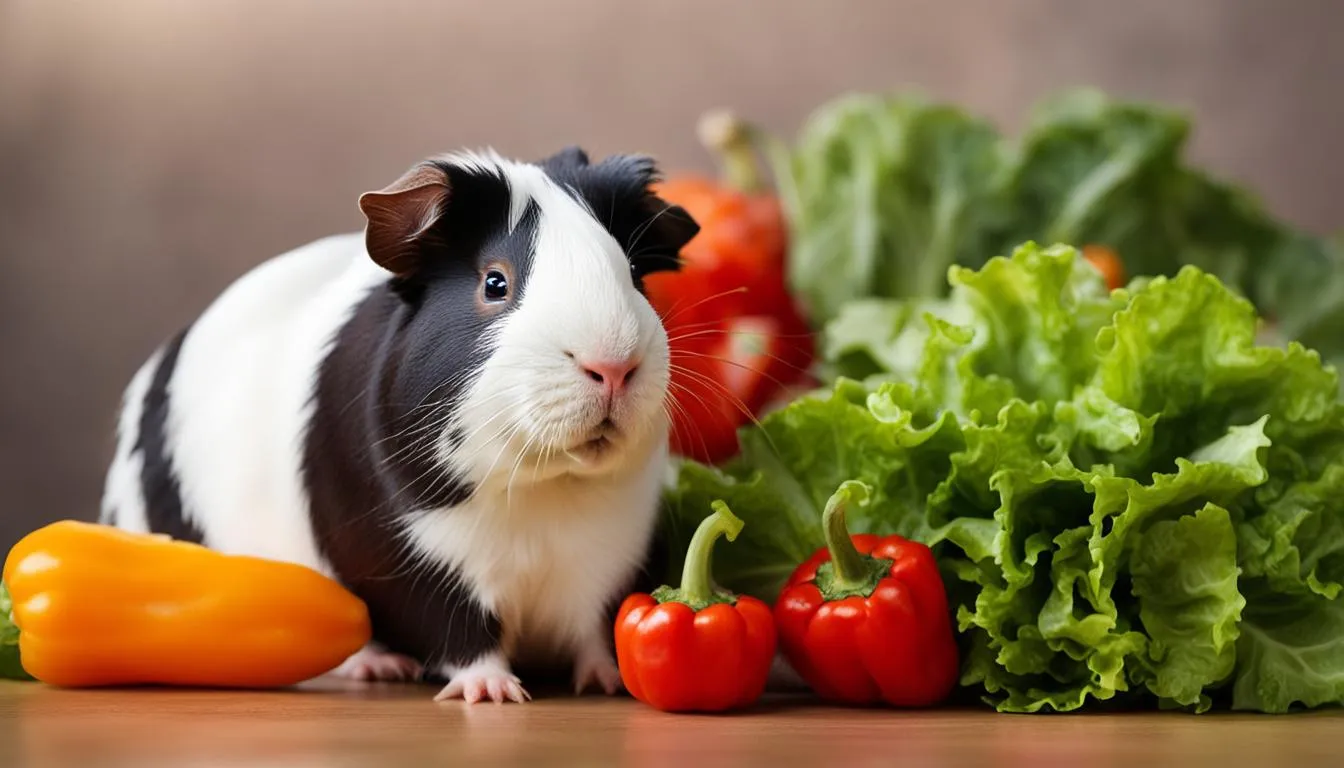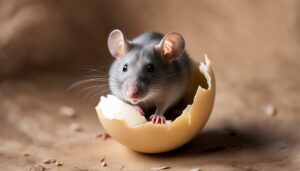Guinea pigs are popular pets known for their adorable appearance and unique dietary needs. As a responsible guinea pig owner, it is important to provide a nutritious and well-balanced diet for your furry friend.
One common question that arises is whether guinea pigs can safely consume red bell peppers. In this article, we will explore the suitability of red bell peppers in a guinea pig’s diet and the nutritional benefits they offer.
Key Takeaways:
- Guinea pigs can safely eat red bell peppers as part of their diet.
- Red bell peppers are high in vitamin C, which is essential for guinea pigs since their bodies cannot produce it.
- It is recommended to feed guinea pigs a few inches square of red bell pepper a few times a week, mixed with other safe vegetables.
- The seeds and pith of the bell pepper are also safe for guinea pigs to consume.
- Red bell peppers provide numerous health benefits for guinea pigs, including promoting a strong immune system and eye health.
What Parts of a Bell Pepper Are Safe for Guinea Pigs to Eat?
Guinea pigs can safely enjoy various parts of a bell pepper, including the seeds and pith. Unlike other seeds that may pose a choking hazard, bell pepper seeds are safe for guinea pigs to consume.
The seeds are rich in fiber and can provide additional texture and stimulation during mealtime. Additionally, guinea pigs can also consume the white pith, or placenta, of the bell pepper.
This part of the pepper is packed with nutrients and can be included in their daily vegetable portion.
It is essential to note that while guinea pigs can enjoy bell pepper seeds and pith, they should avoid consuming other types of pepper seeds such as peppercorns or spicy chili peppers.
These peppers are not suitable for their consumption and may cause digestive issues or discomfort.
What Parts of a Bell Pepper Are Safe for Guinea Pigs to Eat?
To summarize, guinea pigs can safely eat bell pepper seeds and pith. These parts of the pepper are not only safe but also provide additional nutrition and variety to their diet.
However, it is crucial to avoid other types of pepper seeds that are not suitable for guinea pigs’ digestive systems.
| Bell Pepper Parts | Safety for Guinea Pigs |
|---|---|
| Seeds | Safe to eat and provide fiber |
| Pith (Placenta) | Safe to eat and rich in nutrients |
| Peppercorns or spicy chili peppers | Not safe to eat and may cause digestive issues |
Nutritional Value of Red Bell Peppers for Guinea Pigs
Red bell peppers are a highly nutritious addition to a guinea pig’s diet. They are particularly rich in vitamin C, which is essential for guinea pigs since they cannot produce this vitamin on their own.
In fact, red bell peppers contain even more vitamin C than oranges, strawberries, or broccoli, with 127.7 mg per 100g.
Including red bell peppers in your guinea pig’s diet can help support a healthy immune system, promote overall well-being, and prevent illnesses like scurvy.
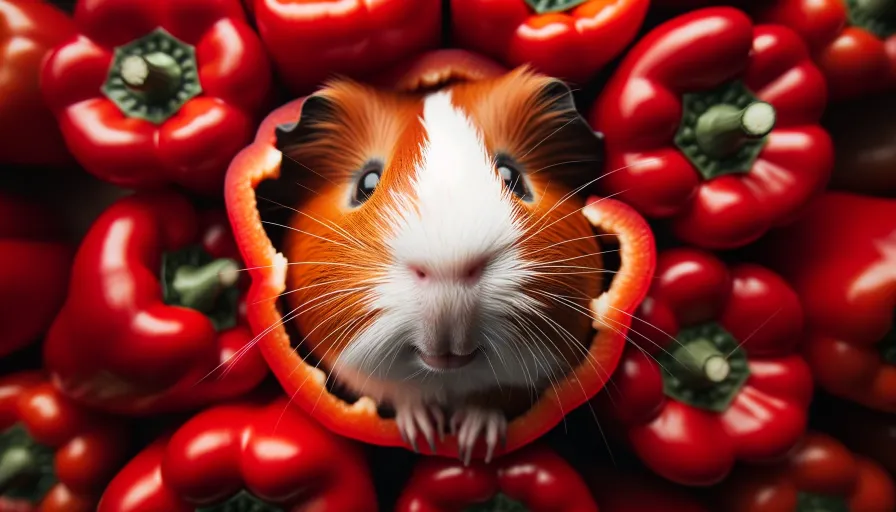
While red bell peppers are a great source of vitamin C, it’s important to note that they also have a higher sugar content compared to green bell peppers.
Therefore, it’s recommended to feed red bell peppers to guinea pigs 2-3 times a week, in moderation.
This ensures they receive the benefits of the vitamin C without consuming excessive sugar. It’s also a good idea to vary the colors of bell peppers, offering green, yellow, and orange varieties, to provide a wider range of antioxidants and nutrients.
| Nutrient | Red Bell Peppers (per 100g) |
|---|---|
| Vitamin C | 127.7 mg |
| Vitamin A | 3131 IU |
| Vitamin K1 | 6.3 μg |
| Potassium | 211 mg |
| Folate | 10 μg |
In addition to vitamin C, red bell peppers also provide other essential vitamins and minerals. They contain a significant amount of vitamin A, which supports eye health, as well as vitamin K1, which is crucial for blood clotting.
Potassium, an important electrolyte, contributes to proper heart and muscle function. Furthermore, red bell peppers offer a small amount of folate, a B-vitamin that helps with cell growth and development.
Conclusion
Red bell peppers are a valuable addition to a guinea pig’s diet due to their high vitamin C content and other essential nutrients.
They provide a range of health benefits, including supporting the immune system and promoting eye health.
However, it’s important to feed red bell peppers in moderation, balancing their consumption with other vegetables, and taking into account the higher sugar content compared to green bell peppers.
By incorporating red bell peppers into your guinea pig’s diet, you can help ensure their optimal health and well-being.
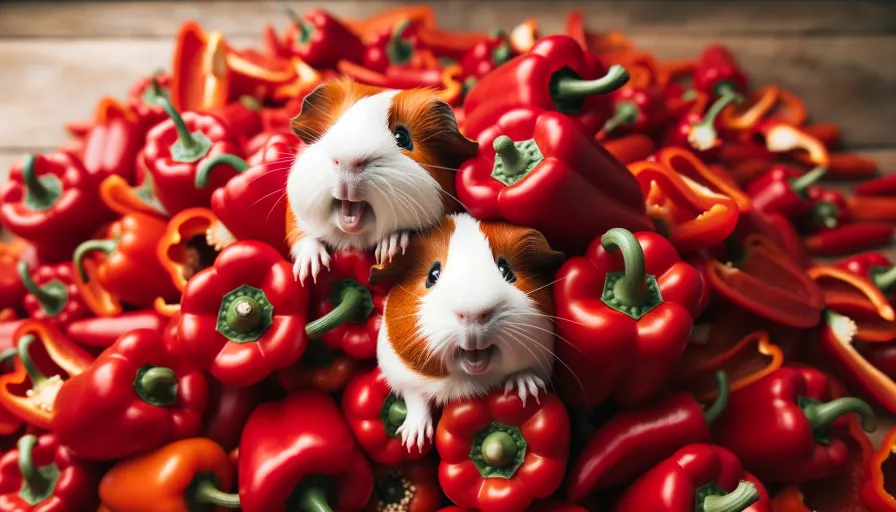
Health Benefits of Red Bell Peppers for Guinea Pigs
Red bell peppers offer numerous health benefits for guinea pigs. Their high vitamin C content is essential for maintaining a strong immune system and preventing illnesses like scurvy.
Vitamin C also plays a crucial role in the formation of collagen, helping to support healthy skin, connective tissues, and blood vessels.
Additionally, red bell peppers contain antioxidants, such as carotenoids like lutein and zeaxanthin, which promote eye health and protect against age-related macular degeneration.
Incorporating red bell peppers into a guinea pig’s diet can also provide other essential vitamins and minerals.
These include vitamin K1, which is important for blood clotting and bone health, as well as potassium, which helps regulate blood pressure and maintain proper heart function.
Red bell peppers are also a good source of folate, which is necessary for cell division and the production of DNA.
To fully understand the nutritional benefits of red bell peppers for guinea pigs, refer to the table below:
| Nutrient | Amount per 100g |
|---|---|
| Vitamin C | 127.7 mg |
| Vitamin K1 | 4.9 μg |
| Potassium | 211 mg |
| Folate | 10 μg |
| Carotenoids (lutein and zeaxanthin) | 341 μg |
It’s important to note that while red bell peppers offer these health benefits, they should be included as part of a balanced diet alongside other safe vegetables for guinea pigs.
This ensures that guinea pigs receive a variety of nutrients and maintain optimal health. Always introduce new foods gradually and monitor your guinea pig for any adverse reactions.
Feeding Red Bell Peppers to Guinea Pigs
Guinea pigs can safely consume red bell peppers as part of their diet. However, due to the higher sugar content compared to green bell peppers, it is important to feed red bell peppers in moderation.
A recommended serving size is about 1/8 to 1/4 of a pepper, depending on the size of the pepper and the preference of your guinea pig.
Incorporating red bell peppers into your guinea pig’s diet is simple. You can slice or cube small pieces of the pepper and mix them with other vegetables in their daily portion.
It is also beneficial to rotate between different colors of bell peppers, such as green, yellow, and orange, to provide a variety of antioxidants and nutrients.
| Feeding Red Bell Peppers to Guinea Pigs | Guidelines |
|---|---|
| Serving Size | About 1/8 to 1/4 of a pepper |
| Frequency | 2-3 times a week |
| Other Colors | Green, yellow, and orange bell peppers can also be fed, but in moderation |
It is important to note that each guinea pig may have preferences when it comes to taste. Green bell peppers have a slightly bitter flavor, while red bell peppers are sweeter.
By offering a variety of colored bell peppers, you can provide both taste variety and nutritional benefits for your guinea pig.
Other Safe Vegetables for Guinea Pigs
In addition to red bell peppers, there are many other safe and nutritious vegetables that you can include in your guinea pig’s diet.
These vegetables not only provide essential vitamins and minerals but also add variety to their meals. Here are some examples of safe vegetables for guinea pigs:
- Leafy greens: Lettuce, spinach, and kale are all excellent options. However, iceberg lettuce should be avoided as it has limited nutritional value.
- Cruciferous vegetables: Broccoli, cauliflower, and Brussels sprouts are all healthy choices for guinea pigs. These vegetables are high in fiber and packed with nutrients.
- Root vegetables: Carrots, radishes, and sweet potatoes can be given to guinea pigs in moderation. These vegetables are a good source of vitamins and minerals.
When introducing new vegetables, it is important to do so gradually. Start with small portions and monitor your guinea pig for any signs of digestive upset.
You can also consult with a veterinarian to ensure that the vegetables you are feeding are safe for your guinea pig.
Nutritional Comparison of Safe Vegetables for Guinea Pigs
| Vegetable | Vitamin C (mg per 100g) | Calcium (mg per 100g) | Iron (mg per 100g) |
|---|---|---|---|
| Lettuce | 5 | 35 | 1 |
| Spinach | 28 | 99 | 2 |
| Kale | 120 | 254 | 1.5 |
| Broccoli | 89 | 48 | 0.7 |
| Carrots | 0 | 33 | 0.6 |
As you can see, different vegetables have varying levels of vitamins and minerals. Including a variety of safe vegetables in your guinea pig’s diet can help ensure that they receive a well-balanced and nutritious meal.
Remember to always wash vegetables thoroughly before feeding them to your guinea pig, and remove any uneaten portions to prevent spoilage.
How to Incorporate Bell Peppers into a Guinea Pig’s Diet
When it comes to incorporating bell peppers into your guinea pig’s diet, there are a few key considerations to keep in mind.
While bell peppers, including red, green, yellow, and orange varieties, are safe for guinea pigs to eat, it’s important to offer them in moderation and as part of a varied selection of fresh foods.
To start, you can mix small slices or cubes of bell pepper with other vegetables in your guinea pig’s daily portion.
This allows them to enjoy the nutritional benefits of bell peppers while also experiencing different flavors and textures.
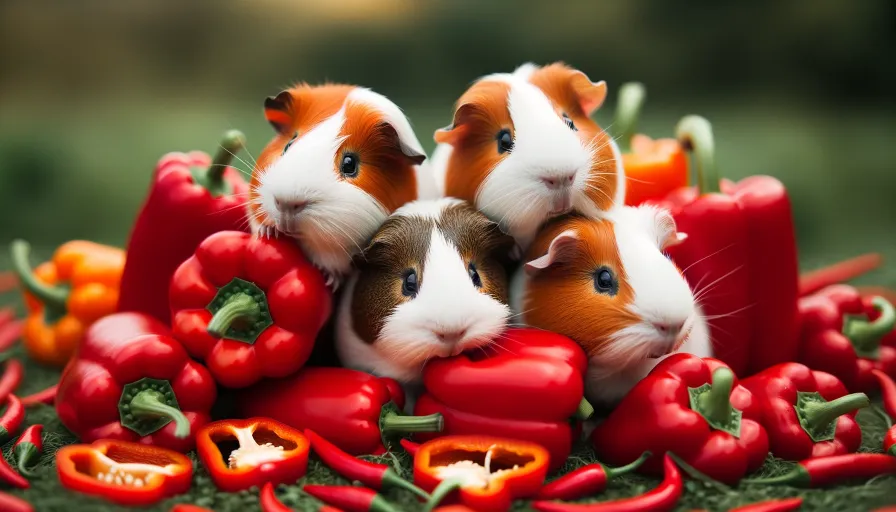
It’s also beneficial to rotate between different colors of bell peppers, as each color offers a slightly different blend of antioxidants and nutrients.
When serving bell peppers to your guinea pig, it’s recommended to provide them with about 1/8 to 1/4 of a pepper per serving, depending on the size of the pepper and your guinea pig’s preference.
It’s important to monitor your guinea pig’s intake and adjust the portion size accordingly to prevent overeating.
Benefits of Incorporating Bell Peppers in Your Guinea Pig’s Diet
Incorporating bell peppers into your guinea pig’s diet provides several benefits. Bell peppers are rich in vitamin C, which is essential for guinea pigs since they cannot produce it on their own.
This vitamin helps support their immune system and overall health. Additionally, bell peppers contain antioxidants and other essential vitamins and minerals that contribute to their well-being.
| Bell Pepper Color | Vitamin C Content (mg per 100g) | Other Nutrients |
|---|---|---|
| Red | 127.7 | Antioxidants, Vitamin K1, Potassium, Folate |
| Green | 80.4 | Antioxidants, Vitamin K1, Potassium, Folate |
| Yellow | 183.5 | Antioxidants, Vitamin K1, Potassium, Folate |
| Orange | 128 | Antioxidants, Vitamin K1, Potassium, Folate |
As with any new food, it’s essential to introduce bell peppers gradually and monitor your guinea pig for any adverse reactions.
By incorporating bell peppers into their diet, you can provide your guinea pig with a tasty and nutritious addition to their meal plan.
Alternatives to Bell Peppers for Vitamin C
If you’re looking for alternatives to bell peppers to provide your guinea pig with vitamin C, there are several options available.
While red bell peppers are an excellent source of this essential nutrient, it’s always beneficial to provide a varied diet to ensure your guinea pig receives a sufficient amount of vitamin C.
Here are some guinea pig-safe fruits and vegetables that are high in vitamin C:
- Strawberries
- Oranges
- Kale
- Parsley
These options can be incorporated into your guinea pig’s diet alongside or as alternatives to bell peppers. It’s important to introduce new foods gradually and monitor your guinea pig for any adverse reactions.
Remember to serve these alternatives in appropriate portions according to your guinea pig’s size and dietary needs.
| Fruit/Vegetable | Vitamin C Content (per 100g) |
|---|---|
| Strawberries | 59 mg |
| Oranges | 53.2 mg |
| Kale | 120 mg |
| Parsley | 130 mg |
These vitamin C-rich options provide a healthy variety to your guinea pig’s diet. Including a mix of bell peppers, strawberries, oranges, kale, parsley, and other suitable fruits and vegetables will help ensure your furry friend gets all the necessary nutrients for optimal health.
Choosing the Right Bell Pepper for Your Guinea Pig
When it comes to choosing bell peppers for your guinea pig, it’s important to consider their preferences and nutritional needs.
Guinea pigs may have different taste preferences when it comes to colored bell peppers. For example, green bell peppers have a slightly bitter taste, while red bell peppers are the sweetest.
Yellow and orange bell peppers fall somewhere in between. By offering a variety of colored bell peppers, you can provide both taste variety and a range of nutrients for your furry friend.
It’s also crucial to consider the size of the bell pepper you choose for your guinea pig. A good rule of thumb is to provide about 1/8 to 1/4 of a pepper per serving, depending on the size of the pepper and the preference of your guinea pig.
Remember, it’s always better to start with smaller portions and observe how your guinea pig reacts before increasing the amount. This will help ensure they don’t overeat or have any digestive issues.
Lastly, it’s essential to source fresh and high-quality bell peppers for your guinea pig. Look for peppers that are firm, with vibrant colors and no signs of wilting or mold.
Organic bell peppers are preferred to minimize exposure to pesticides.
Wash the bell pepper thoroughly before serving it to your guinea pig to remove any dirt or residue. By selecting the right bell peppers and offering them in appropriate portions, you can provide a nutritious and enjoyable addition to your guinea pig’s diet.
Table: Nutritional Comparison of Different Colored Bell Peppers for Guinea Pigs
| Bell Pepper Color | Vitamin C (mg per 100g) | Other Nutrients | Taste Profile |
|---|---|---|---|
| Red | 127.7 | High in vitamin A, vitamin K1, potassium | Sweet |
| Yellow | 127.7 | High in vitamin A, vitamin K1, potassium | Mildly sweet |
| Orange | 127.7 | High in vitamin A, vitamin K1, potassium | Mildly sweet |
| Green | 80.4 | High in vitamin A, vitamin K1, potassium | Slightly bitter |
Conclusion
Red bell peppers are a safe and nutritious addition to a guinea pig’s diet. Their high vitamin C content helps meet the guinea pig’s nutritional needs, as they cannot produce vitamin C on their own.
Feeding red bell peppers, along with other safe vegetables, can promote a healthy immune system, prevent illnesses like scurvy, and support eye health.
Guinea pigs can consume the seeds and pith of the bell pepper, making it easier to incorporate into their daily vegetable portion.
It is important to feed red bell peppers in moderation, about 2-3 times a week, due to their higher sugar content compared to green bell peppers.
It is also beneficial to rotate between different colors of bell peppers to provide a wider range of antioxidants and nutrients.
For guinea pigs that have preferences in taste, green bell peppers have a slightly bitter taste, while red bell peppers are the sweetest.
Yellow and orange bell peppers fall in between. By offering a variety of colored bell peppers, guinea pigs can enjoy both taste variety and the nutritional benefits of bell peppers.
Remember to provide a balanced diet for guinea pigs, incorporating other safe vegetables and fruits that are high in vitamin C.
With a well-rounded diet, including red bell peppers, guinea pigs can maintain optimal health and indulge in a tasty treat.
FAQ
Can guinea pigs safely eat red bell peppers?
Yes, guinea pigs can safely eat red bell peppers, along with other colors such as green, yellow, and orange.
Are the seeds and pith of bell peppers safe for guinea pigs?
Yes, the seeds and pith of bell peppers are safe for guinea pigs to consume.
Why are red bell peppers recommended for guinea pigs?
Red bell peppers are high in vitamin C, which is essential for guinea pigs since their bodies cannot produce it on their own.
How much red bell pepper should I feed my guinea pig?
It is recommended to feed guinea pigs a few inches square of red bell pepper a few times a week, mixed with other safe vegetables.
Are red bell peppers the only vegetables guinea pigs can eat?
No, guinea pigs can also consume a variety of other safe vegetables such as lettuce, spinach, broccoli, carrots, and radishes.
How should I incorporate bell peppers into my guinea pig’s diet?
You can mix small slices or cubes of bell pepper with other vegetables in their daily portion.
What are some alternatives to bell peppers for vitamin C?
Some guinea pig-safe fruits and vegetables that are high in vitamin C include strawberries, oranges, kale, and parsley.
How do I choose the right bell pepper for my guinea pig?
Guinea pigs may have preferences when it comes to the taste of different colored bell peppers, so it’s best to observe their preferences and offer a variety of colors.

